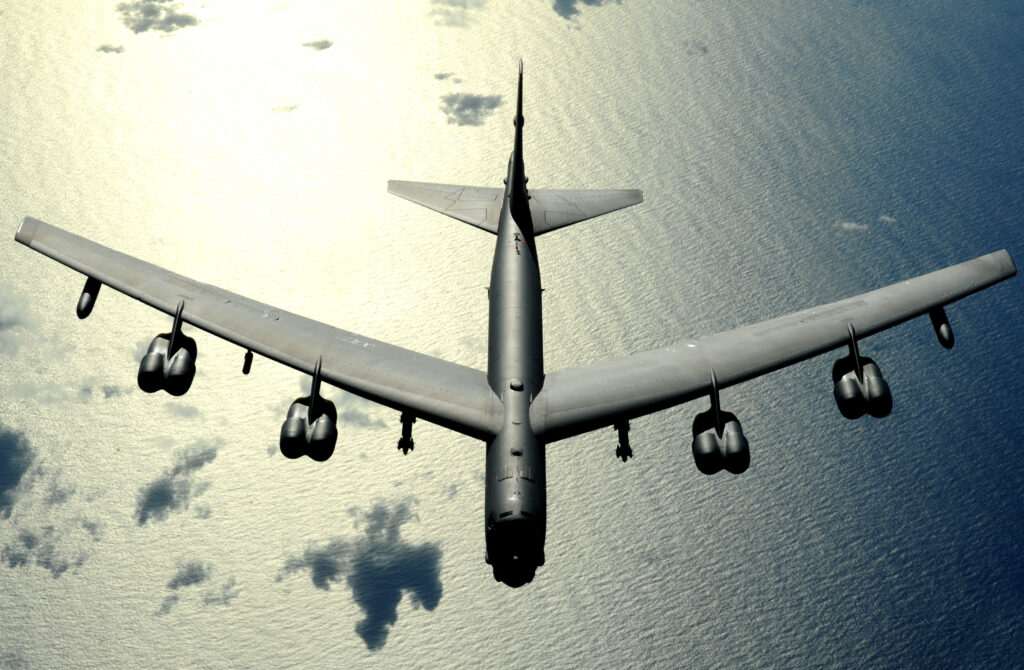Robot Boats, Smart Guns & Super B-52s: Carter’s Strategic Capabilities Office
Posted on
WASHINGTON: Arsenal plane. It’s a great name, no? And the Hyper Velocity Projectile. Whoa. Fast flying swarming micro drones. Neat!
There’s much more being developed, but it’s classified. Where is all this coming from? The Strategic Capabilities Office, or SCO for short. Defense Secretary Ash Carter talked up the new office in his 2017 budget preview speech on Tuesday morning. I understand the SCO is not only developing key capabilities: It is the home of much of what Carter’s calling the Third Offset Strategy, the Pentagon’s effort to bolster America’s global power in ways that Russia and China cannot easily counter.
Carter created it in 2012 “to help us to re-imagine existing DOD and intelligence community and commercial systems by giving them new roles and game-changing capabilities to confound potential enemies — the emphasis here was on rapidity of fielding, not 10 and 15-year programs. Getting stuff in the field quickly.”
Since he clearly thought they were doing a good job, Carter expanded the role of the office to make longer-term investments as well, which makes sense given that it’s the Strategic Capabilities Office.
To run the SCO, Carter picked William Roper, who, he extolled as “a talented physicist” (Carter is a theoretical physicist) who is “also, by the way, a Rhodes Scholar” (Carter is a Rhodes Scholar).
But let’s look at the weapons.
The arsenal plane sounds a great deal like a B-52 with tons of sensors and weapons. Here’s Carter description. It uses “one of our oldest aircraft platforms (the newest B-52 was built in 1964) and turns it into a flying launchpad for all sorts of different conventional payloads. In practice, the arsenal plane will function as a very large airborne magazine, network to fifth generation aircraft that act as forward sensor and targeting nodes, essentially combining different systems already in our inventory to create holy new capabilities.”
Colin tried to get some details about the plane. The Air Force’s Rapid Capabilities Office is not involved with the arsenal plane, though it would seem a natural fit. The RCO, after all, did oversee development of the Long Range Strike Bomber (LRSB) and much of its technology. He couldn’t confirm whether it is, as seems likely, a bitching version of the B-52 bomber, but it certainly makes sense.
It seems likely that they will be upgraded with the ability to use Northrop Grumman’s Multifunction Advanced Data Link (MADL) or something similar to suck down the enormous amounts of unique targeting and threat data gathered by F-35s and F-22s. Then perhaps they’ll add the ability to carry magazines of missiles and other precision weapons.
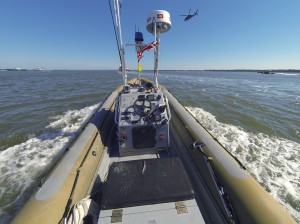
A Navy patrol boat converted to operate unmanned as part of an Office of Naval Research experiment in autonomous “swarms.”
Some of this is not new — it’s just been overlooked. Mackenzie Eaglen of the American Enterprise Institute, knows her way around the Pentagon budget and dug into it to find a number of data points about the SCO dating back to the fiscal 2013 budget. Among the projects were three mentioned by Carter in his speech: flying and underwater swarming micro drones and Hyper Velocity Projectiles.
In another document (on page 529), Eaglen found that “there was a huge jump in funding for SCO from $125 million in 2014 to $175 million in 2015 and $530 million (total in a couple of line items) in 2016.” It includes the Navy’s Sea Dragon and the Unmanned Aerial Vehicle (UAV) payloads project “for micro-UAVs capable of autonomous swarming behaviors, and the Sea Mob project to develop a group of Unmanned Surface Vehicles capable of cooperative swarming.”
In his speech, Carter described Sea Mob this way: “And for the water, they’ve developed self-driving boats (which we’re reported about) which can network together to do all kinds of missions, from fleet defense to close-in surveillance, without putting sailors at risk. Each one of these leverages the wider world of technology. For example, the microdrones, I mentioned a moment ago, use a lot of commercial components and are actually 3-D printed and the boats build on some of the same artificial intelligence algorithms that long-ago and in a much more primitive form were on the Mars lander.”
Shooting A Missile With A Bullet
Sydney has been researching the Hyper Velocity Projectile for some time. Of the four high-tech projects Defense Secretary Ash Carter touted in his speech, HVP is literally the most explosive. It’s is a precision-guided artillery shell that Army howitzers or Navy deck guns could some day use to shoot down incoming missiles.
“We’re taking some of the same hypervelocity smart projectiles that we developed for the electromagnetic…railgun and using it for point defense,” Carter said Tuesday. “By firing it with artillery we already have in our inventory, including the five-inch guns on the front of every Navy destroyer and also the hundreds of Army Paladin self-propelled howitzers” (and hundreds of towed M777 howitzers in the Army and Marine Corps inventory as well).
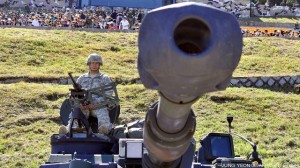
M109 Paladin howitzer
Why does this matter? It’s easier to build a Scud and lob it in someone’s general direction than to build an interceptor to shoot the Scud out of the air. That means adversaries like Russia, China, and even Iran or North Korea can swamp our expensive defenses with cheap offensive weapons until we run out of shots.
One of the great attractions of laser weapons is their potential to destroy incoming missiles while only expending a few dollars’ worth of electricity per shot. Similarly, the Navy’s electromagnetic rail gun uses electricity to shoot a $25,000 Hyper Velocity Projectile at Mach 7 out to over a 100 miles, hitting hard enough to damage warships and fast enough to intercept missiles. But both lasers and rail guns are still in development and would require more electrical power than currently available on most ships in the fleet. So the Office of Naval Research and the SCO are repackaging the rail gun projectile — the HVP — to be fired by traditional cannon, of which there are hundreds already in service.
Already, the 155 mm Excalibur precision-guided shell is in wide use with the US Army artillery against ground targets, and manufacturer Raytheon is developing a variant for naval guns to kill fast attack boats. Some BAE Systems smart shells have fins and even rocket motors that considerably boost range, as well.
“The technologies to enable gun-based precision munitions are there, and now it’s a matter of continuing to advance them,” said Chris King, the retired Army colonel who heads business development for BAE’s weapon systems division.
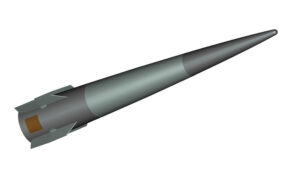
BAE Hyper Velocity Projectile (HVP)
HVP is a BAE Systems product. BAE also developed two rocket-boosted munitions. The 230 lb, 63 nautical mile range Long-Range Land Attack Projectile (LRLAP) is now being built by Lockheed Martin for the Navy’s DDG-1000 Zumwalt destroyers, which have a unique 155 mm naval gun. The 100 lb, 54-nm Multi-Service Standard Guided Projectile (SGP) is a BAE-funded project to build a common smart shell for both Army 155 mm howitzers and Navy five-inch (127 mm) deck guns.
“Both LRLAP and SGP provide ample evidence that industry, or at least BAE Systems, is turning the corner on a rocket motor being able to survive a gun blast,” King said.
By contrast, the Hyper Velocity Projectile lacks a rocket motor. That makes HVP cheaper, smaller — 68 lbs — and shorter-ranged: about 50 nautical miles out of a properly modified naval gun. Compared to the larger, rocket-boosted LRLAP and SGP, the HVP can’t carry as large a warhead as long a distance, so it’s arguably less suited for traditional targets such as ships at sea and troops ashore. Its smaller size, however, allows it a greater agility, which means it has a potential to do missile defense that the budget projectiles don’t.
In fact, the core of the HVP — the “flight body” that contains guidance and warhead — is just 28 pounds. By packaging that core in different ways, you can fire it at different kinds of targets — a surface ship versus a cruise missile, for instance — and out of different weapons, either the electromagnetic rail gun or traditional gunpowder cannon.
“Although it was ultimately it is intended for the rail gun, the Navy and DoD have always seen it as something that would be capable of going out of other guns,” King told me. “The flight packages have to be different.”
How different? Well, the muzzle velocity, maneuverability, and precision that a smart shell requires are much less against a stationary target on land — where you can just home in on GPS coordinates without an active seeker — than it is against a moving target like a ship — where the shell must constantly update target position and adjust course. A small, high-speed, potentially supersonic target like an incoming missile is hardest of all.
Nor is upgrading the HVP itself enough for the kind of missile defense mission Carter envisions: The gun that fires it also needs an upgrade. “There’d probably have to be some modifications to the guns in order to get the higher velocities needed, [such as] maybe different propellant,” King told me. To get a high enough rate of fire to shoot down a salvo of incoming missiles, he continued, “there may need to be automated [reloading] systems. There may need to be things that have to be done in order to improve barrel life.”
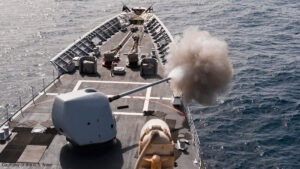
Navy Mark 45 5-inch cannon firing
“It’s not like you can just develop HVP and leave the guns the way they are,” King said. Even using the new projectile for traditional cannon missions — hitting surface targets on land or sea — would require some changes, King said: “No matter what we do there’s going to have to be some modifications to the gun.”
You’d also have to modify or invent the fire control and sensor systems that tell the gun where to point and the projectile where to go. In the Navy, the obvious architecture is the Aegis air and missile defense system already on destroyers and cruisers, although how HVP would plug in is to be determined. The Army’s closest equivalent, the Integrated Air & Missile Defense Battle Command System (confusingly contracted to IBCS), is still in development.
Carter & co. talk about HVP as a cheap way to get new use out of old weapons. Developing HVP for missile defense is indeed cheaper than building an arsenal of high-end interceptors or all-new laser weapons. But the system needs a great deal more work before it can shoot down incoming missiles. Said King, “this is all stuff that still has to be developed.”

DIUx director George Duchak
But Wait, There’s More!
There are other technologies described in Carter’s speech, but we’ll let you read the speech for those.
So where does SCO fit with Carter’s other big new innovation push, known as DIUx (Defense Innovation Unity – eXperimental), the tiny office he set up in Silicon Valley to encourage the tech world to work more closely with the Pentagon after decades of deep mistrust and a general sense that the military had little to offer the entrepreneurs there.
“While there is clearly some limited overlap between SCO and DIUx (Defense Innovation Unit – Experimental), it seems the former was set up to focus on transitioning existing technologies, whereas DIUx is without money and serving in more of a matchmaker role between hi-tech companies and the Pentagon to help introduce new commercial capabilities into the Department,” Eaglen opined. She offered Pentagon decision makers an intriguing idea on how to make DIUx and SCO work better.
“To me, the question really is if these two offices are working together deliberately at all? My guess is, not currently. But in a perfect world, DIUx would identify a breakthrough technology and then SCO would take it and run or short-circuit the testing regime and acquisition system to get it under review,” she said. “The way it reads is that one office feeds the other (DIUx —> SCO), directly or indirectly.”
Subscribe to our newsletter
Promotions, new products and sales. Directly to your inbox.

